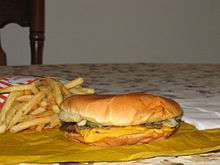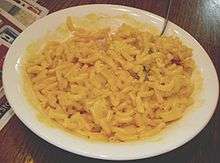Social class differences in food consumption

People from different social classes eat different foods. Not all foods are available to everyone. People start to learn to like foods that are appropriate to their class while they are children. Based on the food that people decide to consume, their social class position is often revealed.[1]
People from the middle classes generally enjoy healthier diets than their lower class counterparts.[2] Part of the explanation for this is that middle class mothers tend to be less permissive in their food choices, are less concerned with the cost of food products, and are more attuned to issues of health.[2] However, permissiveness, health and cost considerations are insufficient to account for the social class variation in food consumption.[2]
Social class differences in food consumption are not necessarily static. A study of Finnish consumption patterns for the period from 1979 to 1990 found that across all classes the consumption of butter, high-fat milk, coffee and sugar had decreased and the consumption of vegetables had increased. From the mid-1980s, social class differences in food consumption had diminished with the lower social classes following consumption patterns established by the upper classes.[3]
Pierre Bourdieu
Author of Distinction: A Social Critique of the Judgment of Taste, French sociologist Pierre Bourdieu wrote extensively on how people of different social classes (specifically the working class) choose what they eat. According to Bourdieu, there isn't much of a choice when it comes to food regarding the working class.[1] The middle class decides which foods are "good" and "bad", which in turn influences what the working class consumes.[1] While the middle class can afford to eat whatever they'd like, the working class simply has a "taste for necessity" and eats what they can afford.[1]
Food deserts
A food desert is a geographical area that lacks adequate grocery stores or markets that provide fresh and nutritious foods that are financially accessible to the people within the area.[4] Food deserts are often found in lower income neighborhoods, which in turn limits the availability of higher quality foods to residents of these neighborhoods.[4] Since the residents of these areas are not able to consistently shop for groceries within a reasonable distance from where they reside, this results in their regular consumption of foods considered unsuitable for maintaining a healthy and nutritious diet (i.e. fast food or food from convenience stores).[4]
In the United States

People tend to define types of foods as belonging to a certain class based on how expensive (or inexpensive) they are.[5] In a study done on students who were asked to categorize restaurant menu items into each of the different social classes, students considered cheap, simple meals lower-class while meals that were much more expensive and came with a choice of wine were considered upper-class.[5]
Since the early 2000's, restaurants and fast-food chains have been incorporating gourmet hamburgers into their menus which often consist of high-end or exotic ingredients.[6] While people of all social classes have access to fast-food restaurants that sell "better burgers" (which are burgers that are considered to be of greater quality than the traditional burger), some restaurants sell expensive burgers that are exclusive to those who can afford them.[6]
In Canada

Food-secure Canadians perceive Kraft Dinners as comforting while food insecure Canadians find it discomforting.[7] This is due to the fact that the food-secure Canadians can afford to eat meals other than those made by Kraft, while food-insecure Canadians have very few options. Furthermore, Kraft meal kits are often found at food banks and charities which contributes to the reason why food-insecure people who visit these places find them undesirable.[7]
References
- 1 2 3 4 Deeming, Christopher (2013). "The choice of the necessary: class, tastes and lifestyles". The International Journal of Sociology and Social Policy. 34.7/8: 438–454.
- 1 2 3 Hupkens, C. (2000). "Social class differences in food consumption. The explanatory value of permissiveness and health and cost considerations". The European Journal of Public Health. 10 (2): 108–113. doi:10.1093/eurpub/10.2.108.
- ↑ Prättälä, R.; Berg, M. A.; Puska, P. (1992). "Diminishing or increasing contrasts? Social class variation in Finnish food consumption patterns, 1979-1990". European journal of clinical nutrition. 46 (4): 279–287. PMID 1600925.
- 1 2 3 Bedore, Melanie. "Food Desertification: Situating Choice and Class Relations within an Urban Political Economy of Declining Food Access". Studies in Social Justice. 8.2: 207–28.
- 1 2 Wright, Wynne; Ransom, Elizabeth. "STRATIFICATION ON THE MENU: USING RESTAURANT MENUS TO EXAMINE SOCIAL CLASS". Teaching Sociology. 33.3: 310–316.
- 1 2 Caldwell, Mark. "The Rise of the Gourmet Hamburger". Contexts. 13.3.
- 1 2 Rock, Melanie; Mcintyre, Lynn; Rondeau, Krista. "Discomforting Comfort Foods: Stirring Pots on Kraft Dinner and Social Inequality in Canada". Agriculture and Human Values. 26.3: 167–76.
Further reading
- Germov, John; Williams, Lauren (2008). A sociology of food and nutrition: the social appetite. Oxford University Press. ISBN 978-0-19-555150-1. Retrieved 22 August 2011.
- Vannoni, F.; Spadea, T.; Frasca, G.; Tumino, R.; Demaria, M.; Sacerdote, C.; Panico, S.; Celentano, E.; Palli, D.; Saieva, C.; Pala, V.; Sieri, S.; Costa, G. (2003). "Association between social class and food consumption in the Italian EPIC population". Tumori. 89 (6): 669–678. PMID 14870832.
- Gibson, S.; Williams, S. (1999). "Dental Caries in Pre–School Children: Associations with Social Class, Toothbrushing Habit and Consumption of Sugars and Sugar–Containing Foods". Caries Research. 33 (2): 101–113. doi:10.1159/000016503. PMID 9892777.
- Drewnowski, A. (2010). "The cost of US foods as related to their nutritive value". American Journal of Clinical Nutrition. 92 (5): 1181–1188. doi:10.3945/ajcn.2010.29300. PMC 2954450
 . PMID 20720258.
. PMID 20720258. - Irala-Estévez, J. D.; Groth, M.; Johansson, L.; Oltersdorf, U.; Prättälä, R.; Martínez-González, M. A. (2000). "A systematic review of socio-economic differences in food habits in Europe: Consumption of fruit and vegetables". European journal of clinical nutrition. 54 (9): 706–714. doi:10.1038/sj.ejcn.1601080. PMID 11002383.
- Hulshof, K. F. A. M.; Brussaard, J. H.; Kruizinga, A. G.; Telman, J.; Löwik, M. R. H. (2003). "Socio-economic status, dietary intake and 10 y trends: The Dutch National Food Consumption Survey". European Journal of Clinical Nutrition. 57 (1): 128–137. doi:10.1038/sj.ejcn.1601503. PMID 12548307.